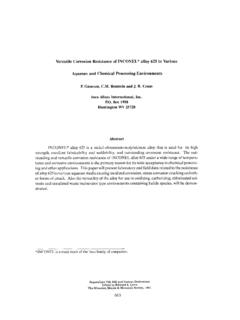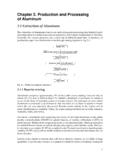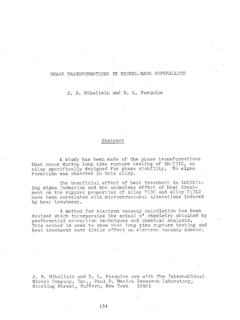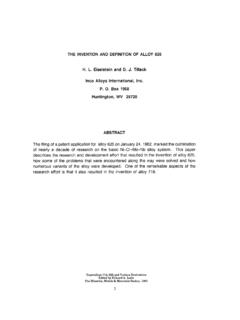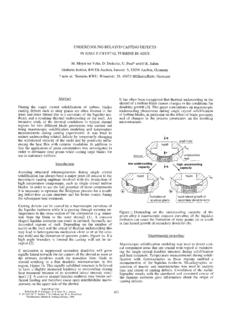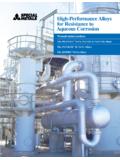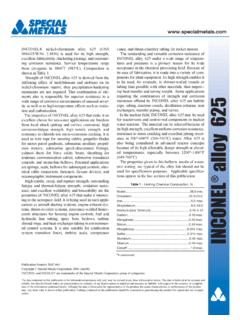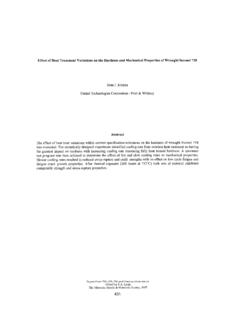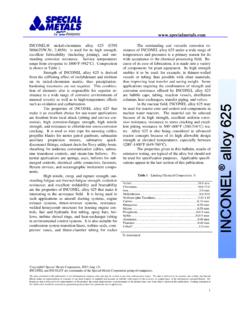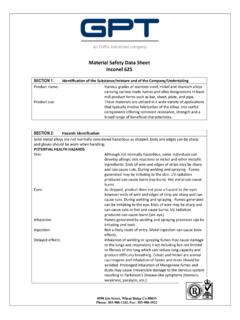Transcription of Understanding and Modeling of Grain Boundary …
1 Understanding AND Modeling OF Grain Boundary pinning ININCONEL 718 Andrea Agnoli1,2, Marc Bernacki1, Roland Log e1, Jean-Michel Franchet2, Johanne Laigo2, Nathalie Bozzolo11 Cemef, 1 rue Claude Daunesse; Sophia Antipolis, 06904, France2 Snecma Gennevilliers, 171 boulevard Valmy; Colombes, 92702, FranceKeywords: inconel 718, Zener pinning , Numerical simulation, Grain growthAbstractThe microstructure stability during sub-solvus anneal-ing was investigated in inconel 718 alloy. A referencedynamically recrystallized microstructure was producedthrough thermomechanical processing (torsion). Thereference microstructure evolution during annealing wasanalyzed by EBSD ( Grain size, intragranular misorien-tation) and SEM ( phase particles). Results confirmthat, in the absence of stored energy, the Grain struc-ture is controlled by the phase particles, as predictedby the Zener equation.
2 If the reference microstructureis strained ( < ) before annealing, then stored en-ergy gradients between grains will induce selective graingrowth leading to coarsening. The phenomenon is con-trolled by the balance of three forces (acting on bound-aries migration) having the same order of magnitude:capillarity, stored-energy and pinning forces. All theseforces could be modeled in a single framework by thelevel set method. The first numerical results demon-strate the capability of the method to simulate 2D mechanical properties of inconel 718 are greatly in-fluenced by the microstructure that has to be fine andhomogenous to ensure the resistance in service condi-tions. Hence, the control of microstructure evolutionduring metal forming is a crucial aspect [1, 2].
3 The sta-bility of the microstructure has to be under control dur-ing each stage of thermomechanical processing, notablyduring the annealing stage. In inconel 718, the pres-ence of phase particles (Ni3Nb) is exploited during sub-solvus annealing ( at a temperature below thesolvus temperature of particles) to limit Grain growththrough the Zener pinning effect. Nonetheless, undercertain conditions the driving forces for Grain bound-ary migration overcome the pinning force leading to thecoarsening of the microstructure. In fact, Grain bound-ary migration is driven by two main factors: the capil-larity force (linked to the Grain Boundary curvature) andthe stored energy difference across the Grain Boundary (linked to the local dislocation density).The aim of this paper is to investigate the influenceof the distribution of phase particles and deformationstored energyon the microstructure stability during sub-solvus partExperimental techniquesThe stability of a reference inconel 718 microstructurewas investigated during sub-solvus annealing (980-1010 C) for 2h in an electrical refer-ence microstructure was obtained by applying a stan-dard sub-solvus thermomechanical processing to torsionsamples, machined from an inconel 718 billet.
4 The cy-cle involved annealing at 980-1010 C, hot deformation(equivalent strain up to ) and then water quench-ing. The chemical composition of the billet is shownin Table 1, while the average Grain size was equal to40 mand the phase surface fraction was less than1%. The radius of torsion samples was 3mm and thegauge length was 15mm. Longitudinal sections werecut (at radius=0): as the strain is linearly proportionalto the radius, this allowed to analyze on the same sec-tion all the strain range from zero (at radius=0) to themaximum value (at radius=3mm). Then samples wereprepared for SEM (ZEISS SUPRA 40 FEG) and EBSD(Bruker CrystAlign) characterization. The preparationconsisted of mechanical grinding, followed by fine polish-ing and finally vibration polishing for at least 12 hours(using an anti-agglomeratingSiO2colloidal solution).
5 1: Chemical composition of the inconel 718 billet(weight percent)The fraction and morphology of phase particles weredetermined by image analysis using the UTHSCSA Im-age Tool software. At least 5 BSE (back-scattered elec-73trons) contrast images per sample were analyzed: eachimage corresponds to an area of 100x150 m. Grainsize and intragranular misorientation were determinedby analysis of EBSD raw data sets using the TSLOIM Analysis software. EBSD measurements were per-formed choosing an appropriate step size ( 1 m) foreach microstructure scale. For the evaluation of grainsize the tolerance angle was set to 5 and twins (definedby a misorientation along the axis<111>equal to 60 with a tolerance of 5 ) were ignored. Intragranular mis-orientation was estimated either by calculating the GOS( Grain Orientation Spread) or the GAM ( Grain Av-erage Misorientation) parameter provided by the OIMsoftware.
6 The GOS is the average misorientation an-gle between each measuring point (in a Grain ) and theaverage Grain orientation. Thus, it does not dependon the step size and it takes into account long-rangeorientation gradients. The GAM is the average mis-orientation angle between each point (in a Grain ) andits neighbors. It depends on the step size as it takesinto account only point-to-point orientation gradients:therefore, when using this parameter the step size mustbe also resultsReference microstructureThe reference microstructureis almost fully (90%) recrystallized. Figure 1 shows thatthe microstructure is equiaxed and the average Grain sizeis about 10 m. Nonetheless it is possible to note thepresence of few bigger grains (30-40 m) which did notrecrystallize.
7 The average phase surface fraction (thatcoincides with the volume fraction if a sufficient numberof measures is considered) was found to be in the rangeof It is to note that a strict control on thefraction of phase, especially at low particles densities,was quite hard to be achieved as chemical compositionheterogeneity in inconel 718 always affects the densityof particles. Figure 2 shows that the distribution andmorphology of the particles is quite heterogeneous. No-tably, if the distribution of the minor axis (or width)of particles is fairly centered around the average value( m), on the contrary the distribution of the majoraxis (length) is wider and spans up to 3 misorientation was evaluated throughthe GOS parameter. This parameter provides relativeinformation about the hardening state of single grains,as the average intragranular misorientation of a graincan be linked to the density of dislocations (which ac-comodate the crystal deformation).
8 Figure 3 showsthe GOS distribution is centered at about , a valuewhich is close to the EBSD system angular the distribution is also very narrow, it can be con-sidered that roughly 90% are strain-free recrystallized(a)(b)Figure 1: Grain size distribution in the reference mi-crostructure: (a) Grain boundaries in black (twins ex-cluded), (b) Grain surface fractiongrains. The rest of the grains are more or less hard-ened: in particular, grains with GOS higher than 3 areclearly unrecrystallized hardened grains. sub-solvus annealingA sample of the reference mi-crostructure was sub-solvus annealed (980-1010 C) for2h to investigate the stability of the microstructure. Thecomparison of Figure 1 and 4 shows that there was lit-tle or no Grain growth despite the high temperature andprolonged annealing time.
9 In fact, as it is well-known inliterature and in the industrial field, the presence of phase particles in inconel 718 can hinder Grain phenomenon is known as Zener pinning and therelation between the stable Grain size and particles canbe described by the following simple equation [3]:< D >= 43< r > < f >,(1)where< D >corresponds to the average diameter of(randomnly distributed spherical) grains,< r >and< f >are respectively the average radius and volume74(a)(b)(c)Figure 2: Distribution of the phase in the referencemicrostructure: (a) BSE image showing the phase assmall white particles and few carbides (NbC) as big-ger particles, (b) minor axis and (c) major axis particlenumber fractionfraction of (spherical) secondary-phase particles and is a constant ( < < ). The value of the pa-rameter is influenced by the microstructure proper-ties (boundaries energies and average curvature, parti-cle distribution and shape, etc,).
10 As shown in Figure 2,the phase morphology is quite complex and particlescan be hardly considered as spheres. Nonetheless, a so-lution is to evaluate the equivalent radius of sphericalparticles having the same volume as experimental parti-cles. Then, it is possible to plot Eq.(1) as a function ofparticle fraction. Figure 5 shows that the experimentaldata obtained by annealing the reference microstructure(ref) falls in between the two curves. Then, despite thesimplicity and all the assumptions behind Eq.(1), it stillallows to understand and describe why significant Grain (a)(b)Figure 3: Grain orientation spread (GOS) distributionin the reference microstructure: (a) Grain boundariesin white, twins in black (white grains have higher GOSvalues than 3 ), (b) GOS surface fractiongrowth did not occur after annealing.
